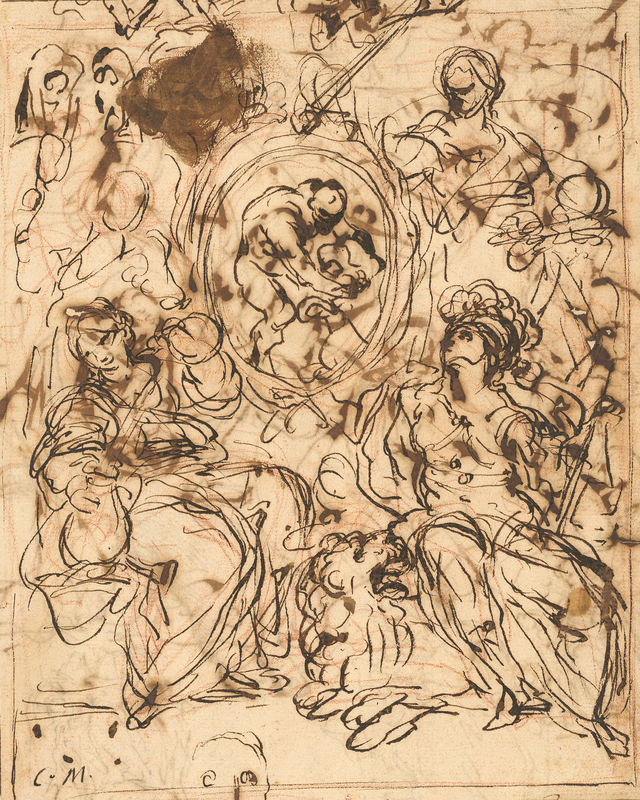Kunsthaus Zürich presents masterpieces of Italian drawing
Carlo Maratti, Hercules Slaying the Nemean Lion (cartouche) with Temperance and Fortitude, c. 1670. Pen in brown over red chalk on paper, 25.9 x 20.9 cm. Kunsthaus Zürich.
ZURICH.- From 31 January to 26 April 2020 the Kunsthaus Zürich presents ‘The Poetry of Line. Masterpieces of Italian drawing’, a selection from its small but prestigious collection of Italian drawings covering the period between Renaissance and Baroque, which have now been examined by students from the University of Zurich.
The cabinet exhibition displays around thirty of the most important works from the Collection of Prints and Drawings at the Kunsthaus Zürich. From the sight of the lines skilfully drawn on the paper it is but a short intellectual leap to the genesis of an artwork.
Raffaello Sanzio (known as Raphael), Figure study for the Expulsion of Heliodorus, c. 1511. Black chalk over stylus underdrawing on brownish-grey paper, 40 x 26.6 cm. Kunsthaus Zürich.
RAPHAEL, CORREGGIO, GUERCINO
Many of the works have long been classics of the Prints and Drawings Collection: they include a preliminary drawing by Raphael for the Vatican ‘stanze’ and the graceful depiction of Lucretia by Palma Vecchio. Others have never even been published before, despite being the work of equally celebrated masters such as Guercino, Correggio and Carlo Maratti. The Collection of Prints and Drawings was transformed into a kind of laboratory to allow them to undergo a detailed inspection.
Jacopo Negretti (known as Palma Vecchio), Lucretia, c. 1526–1528. Black chalk with white highlights on brownishgrey paper, 18.6 x 15.8 cm. Kunsthaus Zürich.
ENCOUNTER WITH THE ORIGINAL
As part of a collaboration with students from the University of Zurich, the drawings were subjected to a hands-on analysis – in the literal sense of the term, because an encounter with the original is crucial to professional attribution and to locating a drawing within its cultural landscape. Many well-known researchers have been involved in such encounters, as the numerous handwritten comments on the works’ mountings attest. Their authors read like a who’s who of international drawing research: Marco Simone Bolzoni, Chris Fischer, Catherine Goguel and Joachim Jacoby are just some of those who have contributed their assessments on individual questions of attribution. Their annotations served as a guideline for further research involving comparisons and recourse to the relevant specialist literature.
Jacopo Zanguidi (known as Bertoia), Seated female figure, study of hand and head, c. 1569–1572. Red chalk on paper, 23.7 x 21.1 cm. Kunsthaus Zürich.
STUDY AND EXPERIENCE TRAIN THE SENSES
Often, however, specialist literature can provide only limited assistance. Art enthusiasts and the curators of prints and drawings collections need to recall comparative examples from their own memories and, not least, rely on their own sensory apparatus to appreciate, for instance, the structure of a sheet of paper, its roughness or smoothness when worked on with ink, chalk or graphite. But the sensual aura of the portraits, landscapes and mythological or Christian scenes depicted, can exert an equal if not greater attraction on visitors.
Curator Jonas Beyer is convinced that university teaching can benefit from synergies with museum practice, especially when students go on to work in fields where dealing with originals is one of the most exciting challenges
Giuseppe Cesari (known as Cavalier d’Arpino), Adam and Eve Banished from Paradise, 1602/1603. Red chalk on paper, 17.3 x 12.8 cm. Kunsthaus Zürich.
Giovanni Francesco Barbieri (known as Guercino), St. Paul Fed by a Raven, c. 1650–1655. Pen in brown on light beige paper, 27.6 x 36.3 cm. Kunsthaus Zürich.
Giovanni Benedetto Castiglione (known as Il Grechetto), Noah Guiding the Animals into the Ark, c. 1660. Brush in brown and red-brown, blue-grey in parts, on light beige paper, 32 x 45.4 cm. Kunsthaus Zürich.
Giovan Gioseffo Dal Sole, Lying naked Youth, c. 1680–1700. Black and red chalk on brownish-grey paper, 37.1 x 54 cm. Kunsthaus Zürich.

/https%3A%2F%2Fprofilepics.canalblog.com%2Fprofilepics%2F1%2F0%2F100183.jpg)
/https%3A%2F%2Fstorage.canalblog.com%2F03%2F02%2F119589%2F96711876_o.jpg)
/https%3A%2F%2Fstorage.canalblog.com%2F11%2F31%2F119589%2F94773502_o.jpg)
/https%3A%2F%2Fstorage.canalblog.com%2F20%2F83%2F119589%2F94772815_o.jpg)
/https%3A%2F%2Fstorage.canalblog.com%2F26%2F72%2F119589%2F75604929_o.jpg)
/https%3A%2F%2Fstorage.canalblog.com%2F59%2F60%2F119589%2F26458628_o.jpg)










/image%2F1371349%2F20240318%2Fob_9e7469_84-2023-a-moretti-1070x1200.jpg)
/http%3A%2F%2Fstorage.canalblog.com%2F82%2F08%2F119589%2F122394483_o.jpg)
/http%3A%2F%2Fstorage.canalblog.com%2F24%2F12%2F119589%2F111170130_o.jpg)
/http%3A%2F%2Fstorage.canalblog.com%2F95%2F42%2F119589%2F110168131_o.jpg)